Customer Case Study
Princess Alexandra Hospital,
Essex
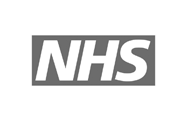
How Enterprise Imaging is transforming patient care
“The trust is now able to see more patients, more quickly and provide a faster and a highly efficient diagnostic service without compromising on quality.”

Jack Oakes
Senior Interventional Radiographer and PACS administrator
Dr Sridhar Redla
Consultant Radiologist and Associate Medical Director for Cancer, Cardiology and Clinical Support Services
Stephen Townrow
Imaging Systems Manager
The Princess Alexandra Hospital NHS Trust (PAHT in the UK serves a population of 350,000 across its three sites – Princess Alexandra Hospital, St Margaret’s Hospital, and Herts and Essex Hospital.
The Princess Alexandra Hospital NHS Trust (PAHT in the UK serves a population of 350,000 across its three sites – Princess Alexandra Hospital, St Margaret’s Hospital, and Herts and Essex Hospital.
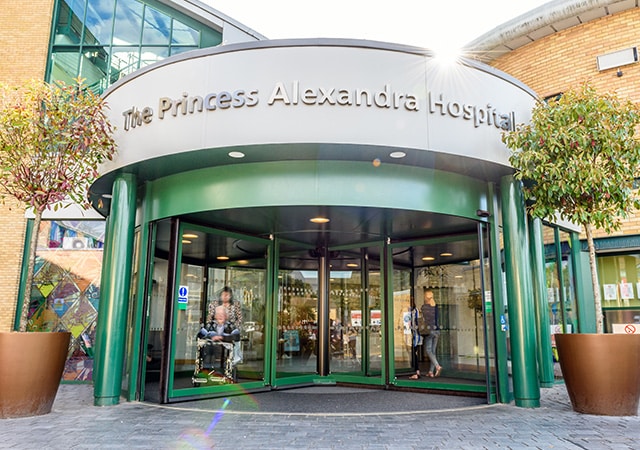
10% year-on-year increase in imaging referrals
It provides a full range of acute services, including 24-hour A&E, elderly, paediatric, cancer, heart, surgical and emergency medicine as well as comprehensive diagnostic and outpatient services. As is the case with many NHS trusts, PAHT is experiencing growing demand on its services, with its radiology department in particular seeing a 10% year-on-year increase in imaging referrals. So, when the contract for its Picture Archiving and Communication System (PACS) was due for renewal, the trust seized the opportunity to source a next generation system that was better, faster and would be equipped to cope with the increase in demand now and in the future.
The challenge
With the task of processing 300,000-350,000 imaging studies every year, PAHT found its resources stretched to the limit. There were huge disparities in the time it took to file an imaging report – due mainly to the staff choice of whether to use voice recognition or not with the existing PACS solution.
Stephen Townrow, Imaging Systems Manager explains: “Those radiologists who embraced voice recognition were able to file their reports within 24 hours. The technology was still very clunky and so some staff preferred to stick to dictation, relying on our medical secretaries to type up the reports. In these cases, the report could take three weeks to reach the GP. This proved frustrating for GPs, led to a lot of calls chasing reports and also brought anxiety for our patients who are waiting for sometimes very serious diagnoses.”
Jack Oakes, Senior Interventional Radiographer and PACS administrator adds: “Another major flaw was that if a radiologist was disturbed halfway through writing a report, with a phone call or query, the report it would disappear from their worklist and was very difficult to find again. This resulted in a great deal of duplicated effort and frustration.” AGFA Healthcare’s Enterprise Imaging solution has led to up to a 45% increase in the number of plain film reports produced – 8 per minutecompared to 5 per minute previously. Princess Alexandra Hospital NHS Trust (PAHT) now has zero imaging backlog, with the radiologists now able to report ‘live’. Better quality, more efficient reporting has resulted in a reduction in the need to recall patients for repeat tests. PAHT can provide GPs with reports within 24 hours compared to up to three weeks resulting in patients being seen and treated more quickly and reducing A&E burden. Other issues included a lack of quality control and poor interoperability, with radiologists and radiographers frequently having to switch between as systems – all requiring different logins – to find the information needed. The Trust’s IT Team, Executive Board, Head Radiologist, Imaging Systems Manager and PACS Administrator were all involved in the procurement of the new PACS, which formed part of the trust’s wider digital strategy and goal to transition from paper to digital systems.
They were looking for a solution that would consolidate all of its medical images into one place, removing the practice in some departments of storing archive images on CDs stacked on bookshelves. It needed to be scaleable – to easily allow other modules to be added; to be fast and efficient and able to cope with increasing demand; and to offer an intuitive interface and seamless workflows to support staff.
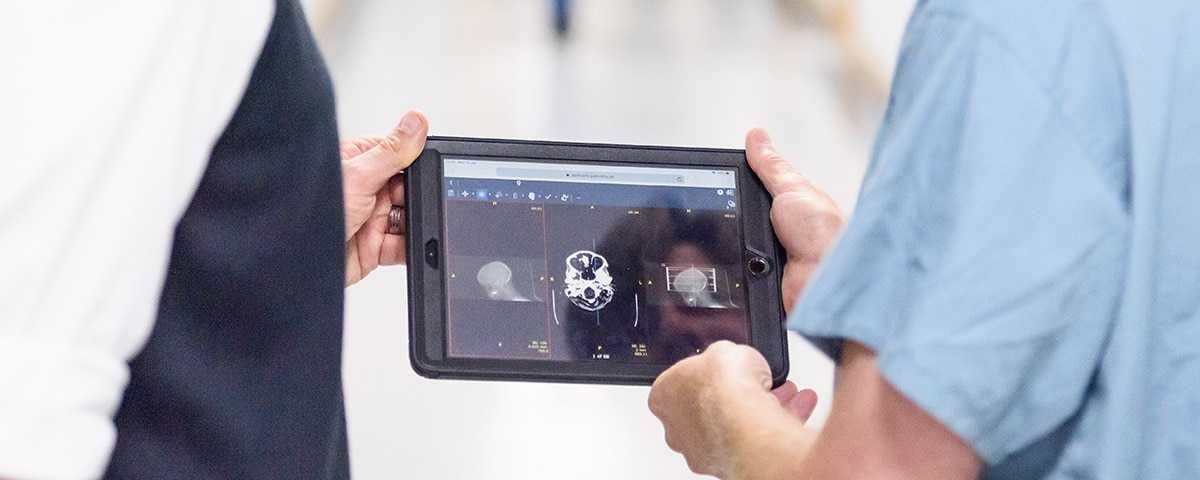
Advantage
Completely paperless workflow with sub-1 second image retrieval
45%
8/min
Princess Alexandra Hospital NHS Trust (PAHT) now has zero imaging backlog, with the radiologists now able to report ‘live’.
0
backlog
AGFA Healthcare’s Enterprise Imaging solution has led to up to a 45% increase in the number of plain film reports produced – 8 per minute compared to 5 per minute previously.
1
less recalls
Better quality, more efficient reporting has resulted in a reduction in the need to recall patients for repeat tests.
24
hours
PAHT can provide GPs with reports within 24 hours compared to up to three weeks resulting in patients being seen and treated more quickly and reducing A&E burden.
Solution
Townrow explains: “We considered 20 systems, before narrowing it down to four suppliers who we invited to tender. One hugely positive factor was just how quickly AGFA could migrate all of our images into Enterprise Imaging (EI). I called my counterpart at a trust that was using another supplier we were considering and discovered it took a couple of years to migrate 600,000 images – with EI we were able to migrate all of our images in a week.”
He adds: “The main driver for moving from PACS based reporting rather than RIS was that it’s a lot slicker and saves time and is far better for workflow. Before we would have 4 to 5 applications open and we’d also have to have a bridge. We now have one system that is faster and has less chance of errors.”
The Enterprise Imaging for Radiology solution provides the trust with a unified imaging platform, which is intuitive to use, has embedded clinical tools as well as reporting functionality and a powerful workflow engine that maximises productivity beyond what the trust thought would be possible. It’s XERO Universal Viewer provides secure access to reports and images and it’s XERO Xtend feature set adds full fidelity view functionality to the solution.
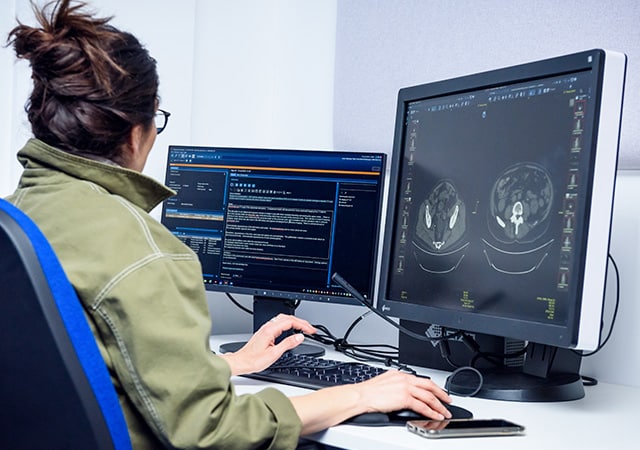
“It is one of the fastest systems I have seen, everything is retrievable in sub-1 second. With that level of speed, we just knew it would have huge benefits to our efficiency and we haven’t been disappointed. We probably have the fastest system in the country.”
“One hugely positive factor was just how quickly AGFA could migrate all of our images into Enterprise Imaging: We now have one system that is faster and has less chance of errors.”
XERO® Universal Viewer
The XERO Univeral Viewer has proved particularly popular as it allows users to easily make annotations and mark-ups or pinpoint an area of interest and compare it across different studies. It also provides the opportunity to see 3D images on orthopedic scans. “Everyone has access to the XERO Universal Viewer not just the radiology department,” explains Townrow. “They can sign in using their windows password and very little training is required.”
Dr Sridhar Redla, Consultant Radiologist and Associate Medical Director for Cancer, Cardiology and Clinical Support Services, was central to the procurement process. As with any competitive tender process, the trust were not sure which supplier would win and therefore whether they would remain with AGFA but the system met all of their needs and, as they had a very positive relationship with AGFA during the previous 10 year contract, it just made sense to stay with them. “If it’s
working, if there’s a good relationship and mutual trust, then why change,” he says.
A seamless transition
As part of the project to implement the new PACS, Townrow took the opportunity to also ensure investments were made in the trust’s infrastructure including storage clusters, fibre optic networking and improvements to server speed tvo ensure that they capitalised on the benefits that EI could provide.
AGFA provided a team to support PAHT with the transition from its legacy PACS platform into EI. They assisted Townrow and his team with initial workflow analysis, testing of the system, training 2,000 users and go-live. “From interface specialists to trainers, they had everyone we needed,” says Townrow. “The implementation was a real team effort and any problems were owned as a team – that’s what made it go so smoothly, we were like a big family.”
He adds: “AGFA is available to provide ongoing support but the system is so straightforward, we just don’t need it. It’s such a slick product – anyone who can use a PACS will know what to do. I had three calls from people who were initially apprehensive but when I showed them the system they could immediately see the benefits.” Chloe Sandham-King, a reporting radiographer had been on maternity leave when EI was implemented. “I was concerned about having to learn a new system,” she says. “It can be overwhelming but the system was so simple and user friendly, I needn’t have worried.”
“The implementation was a real team effort.”
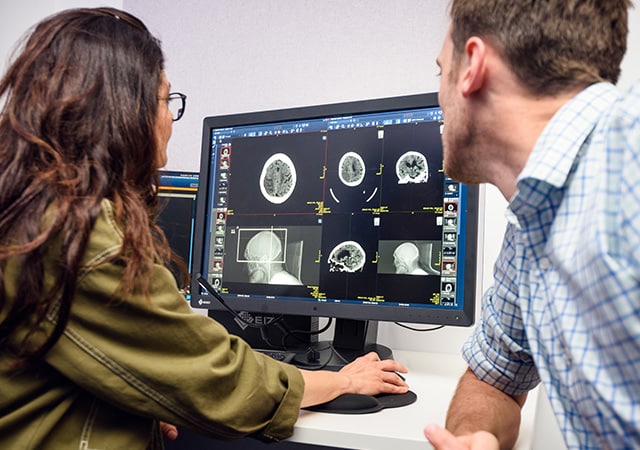
“Thanks to the mobile working capabilities of EI, doctors are able to use iPads on the wards to show patients their scans, which helps to explain any diagnosis and means they are more engaged in their care.”
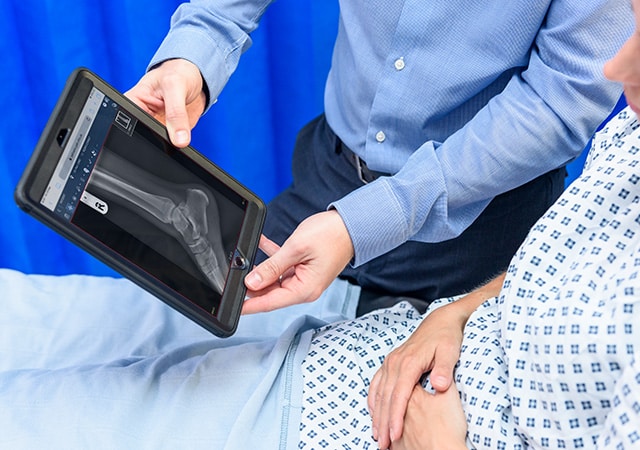
Faster, better patient care
By far, the biggest impact of the EI platform is in the efficiency the department is now achieving. It has resulted in a 45% increase in productivity, reducing all backlogs to zero and allowing live reporting which brings significant benefits to patients and the trust.
In the CQC’s report ‘Radiology Review: a national review of radiology reporting within the NHS in England’, PAHT ranked sixth in the country based on the proportion of Emergency Department (ED) images reported within four-hour target and second in the country based on the proportion of inpatient images reported within 24-hour target. Dr Redla believes this is a direct response to the introduction of EI.
“Before we implemented the system, we would have undoubtedly been ranked in the 20’s for ED and in the teens for inpatients,” he says. “The fact that we are now one of the leading organisations for reporting in both ED and inpatients in the country is without a doubt directly proportional to the efficiencies that the AGFA EI system is bringing combined with our great and proactive staff who continue to see the benefits of using it.”
“The trust is now able to see more patients, more quickly and provide a faster and a highly efficient diagnostic service without compromising on quality.”
Dr Sandra Dimmock, Consultant Radiologist and former Medical Director, explains that live reporting enables radiographic errors to be detected before a patient leaves the hospital. “This benefits the patient as it saves them from an often frustrating and inconvenient return trip for the repeat scan and reduces the trust’s administration burden of recalling the patient. A more serious implication is if you detect something that needs treating immediately, then the patient is still there and can be admitted straight away.”
Dr Redla adds: “After the introduction of EI there are no backlogs for plain radiographs due to improved efficiency and there’s only a small backlog for non-urgent cross section imaging. Some radiologists use the EI functionality and mobile availability at home to help with clearing this, at their convenience and this also gives great flexibility with MDT preparation.” EI also supports GPs as they take on the role of managing urgent but non-life threatening health problems in an effort to reduce the pressure on A&Es. Dr Dimmock explains: “Members of the public know that if they turn up at A&E they can have an x-ray or scan and get the results that day – albeit probably with a long wait. If they know they can get referred for a scan through their GP, and the GP will have the results the next day, they are more likely to pick that option which is better for everyone.”
Benefits to the staff
It is not just patients that are benefiting from EI. The simplicity, usability and intuitiveness of the system is making the reporting process quicker and easier, making it very popular with staff.
Dr Dimmock has seen a dramatic increase in the number of reports she can file a day with EI. “All of the information is displayed on one screen, providing more of the patient’s medical history without needing to scroll. This, along with the voice recognition, makes the reporting much quicker. I can now file up to 800 reports a day, even though I only work part time.”
All staff are now using the voice recognition technology, which, combined with the other efficiencies within the system, has meant the average number of reports staff can file every minute has increased from 5 to 8. “The voice recognition is quite incredible,” explains Oakes. “Our clinicians put it to the test and speak as quickly as they can, some have strong accents, and it still manages to pick up the correct words with accuracy.”
While PAHT has been more fortunate than most, with a much smaller backlog, their staff were still having to work flat-out, in order to stay on top of the work. Now, they have eliminated the backlog, which only took a few weeks, and are able to report the cases “live” while the patients are still at the hospital. Townrow said: “At the start we couldn’t believe it, we were watching the backlog drop off the screen.”
Staff are now also able to take regular breaks, which improves their working day and potentially their attention to detail. This increases job satisfaction, helping with staff retention and attraction.
In addition to the patient and staff benefits, the trust is also reaping the financial rewards of the new platform. Townrow says: “We’ve been able to redeploy typist to other positions and have also saved a considerable amount in image storage costs, as all images are stored centrally which reduces duplication. We would have had to spend £25,000 every couple of years to increase our storage but now we don’t need to do that.”
“Having such a sophisticated radiology system definitely helps to attract talent – you have the right team and the right kit in place to enable them to do their job in the best possible way.”
Dr Sridhar Redla
Consultant Radiologist and Associate Medical Director for Cancer, Cardiology and Clinical Support Services
Improving Quality Control
The EI system is fully auditable, with improved mechanisms for communication between radiologist and radiographers, which allows visibility of errors and enables the trust to identify training needs. This has already resulted in more targeted and effective staff training producing a more skilled and proficient workforce.
“We run monthly reports to look for trends,” explains Oakes. “For example, if the same radiographer is providing poor images then we can look into whether there is a training requirement – it is really helping us to upskill our staff. Radiographers also have the opportunity to put a note for the radiologists. Occasionally, they may have a reason for not being able to provide quality images – if for instance, a patient is being uncooperative – and the radiologist will know they need to work with the image they have. The downside is that we don’t see the staff anymore,” jokes Oakes. “They used to come to the office all of the time needing records corrected and support. That doesn’t happen now”.
“Enterprise Imaging has enabled us to increase productivity by 45%, we have improved workflows and communication within our teams, we are upskilling our staff and we have a happier workforce.” This has all led to enormous benefits for our patients in terms of better, faster and more hands-on care, which, of course,is our primary goal.”
Future Benefits
Looking to the future, the trust intends to roll out the platform across other departments, with plans already underway within cardiology, medical imaging and theatre imaging. They are aiming to make full use of the Business Intelligence functionality to create standard and custom reports for governance and for local decision-making on best working practices. They are also hoping to realise the benefits that AI could bring to the system, for example in assisting with case prioritisation and auto-measurement. “There is so much potential here for AI,” enthuses Dr Redla. “Particularly in mammography, where it could help with the staff resource burdens, as there is a national shortage of breast radiologists. EI and AI go completely hand in hand.”
